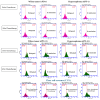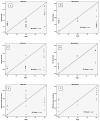Assessment of the Circulating PD-1 and PD-L1 Levels and P53 Expression as a Predictor of Relapse in Pediatric Patients with Wilms Tumor and Hypernephroma
- PMID: 39334568
- PMCID: PMC11430274
- DOI: 10.3390/children11091035
Assessment of the Circulating PD-1 and PD-L1 Levels and P53 Expression as a Predictor of Relapse in Pediatric Patients with Wilms Tumor and Hypernephroma
Abstract
Background/Objectives: Wilms tumor (WT) is the most common form of pediatric renal tumor, accounting for over 90% of cases followed by hypernephroma. Some pediatric patients with WT (10%) experience relapse or metastasis and have poor survival rates. PD-L1 assists cancer cells in escaping damage from the immune system. P53 mutations are found in relapsed WT tumor samples. We hypothesized that testing circulating PD-1 and PD-L1 and P53 expression levels could offer a simple method to predict patient relapse and explore novel treatments for pediatric WTs and hypernephroma. Methods: Flow cytometric detection of cPD-1, cPD-L1, and P53 expression in relapsed and in-remission WT and hypernephroma before and after one year of chemotherapy was performed. Results: Our data shows increased levels of cPD-L1 in relapsed pediatric patients with WT or hypernephroma before and after chemotherapy. There were also slight and significant increases in cPD-1 levels in relapsed groups before chemotherapy. Additionally, we observed significant decreases in P53 expression after one year of chemotherapy in relapsed pediatric patients. Conclusions: Our study found that circulating PD-L1 can be used as a predictor marker for WT and hypernephroma relapse. In conclusion, these circulating markers can assist in monitoring relapse in WT and hypernephroma patients without the need for several biopsies.
Keywords: P53; PD-1; PD-L1; Wilms tumor; hypernephroma; pediatric renal tumor; relapse.
Conflict of interest statement
The authors declare no conflicts of interest.
Figures




Similar articles
-
Clinical significance of tumoral PD-L1 expression in Wilms tumors.J Pediatr Urol. 2022 Feb;18(1):14.e1-14.e8. doi: 10.1016/j.jpurol.2021.10.015. Epub 2021 Oct 26. J Pediatr Urol. 2022. PMID: 34753665
-
Immune expression in children with Wilms tumor: a pilot study.J Pediatr Urol. 2019 Oct;15(5):441.e1-441.e8. doi: 10.1016/j.jpurol.2019.03.011. Epub 2019 Mar 20. J Pediatr Urol. 2019. PMID: 30981637
-
EV PD-L1 Contributes to Immunosuppressive CD8+ T Cells in Peripheral Blood of Pediatric Wilms Tumor.Technol Cancer Res Treat. 2021 Jan-Dec;20:15330338211041264. doi: 10.1177/15330338211041264. Technol Cancer Res Treat. 2021. PMID: 34519584 Free PMC article.
-
Relapse-Free Survival and PD-L1 Expression in First High- and Low-Grade Relapsed Luminal, Basal and Double-Negative P53-Mutant Non-Muscular Invasive Bladder Cancer Depending on Previous Chemo- and Immunotherapy.Cancers (Basel). 2020 May 21;12(5):1316. doi: 10.3390/cancers12051316. Cancers (Basel). 2020. PMID: 32455829 Free PMC article.
-
Treatment of relapsed aggressive lymphomas: regimens with and without high-dose therapy and stem cell rescue.Cancer Chemother Pharmacol. 2002 May;49 Suppl 1:S13-20. doi: 10.1007/s00280-002-0447-1. Epub 2002 Apr 12. Cancer Chemother Pharmacol. 2002. PMID: 12042984 Review.
References
LinkOut - more resources
Full Text Sources
Research Materials
Miscellaneous

